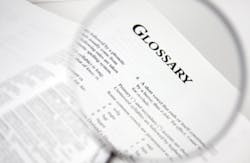The terms below appeared in the September 2015 issue of Flow Control magazine. Thanks to Koch Membrane Systems (KMS), a manufacturer of innovative membrane filtration systems (www.kochmembrane.com) for supplying this glossary. More Filtration & Separation terms from KMS appeared in the May 2015 edition of Flow Control. Access the May glossary (Part 1) here.
BIOLOGICAL CONTROL: Removal of biological contamination, such as bacteria, viruses, and other living pathogens from drinking water.
BIOREACTOR: A processing device often paired with membrane filtration that utilizes bacteria to treat wastewater.
CLEAN IN PLACE: A type of chemical cleaning procedure in filtration systems used to remove fouling without disassembly.
CROSS FLOW: A type of filtration in which high feed flowrate is used in membrane filtration to keep the membrane continuously clean/functioning during production. The flow is tangential to the membrane and only a portion of the feed flow is pressurized enough to pass through the membrane pores as permeate.
DESALINATION: Removal of salts and other minerals from saline or brackish water.
FOULING: The deposition of unwanted materials on membranes, such that their performance is degraded and they lose filtration functionality.
HOLLOW FIBER: Membrane configuration that is shaped similar to a straw, where the membrane forms a long, thin tube through which the fluid to be filtered is passed either from the outside or inside. Hollow fiber membrane cartridges include a large number of these straw-shaped membranes.
PACKING DENSITY: The amount of filter surface area in a given area of volume. This measurement is especially important in membrane filtration, where filtration systems with a great deal of filtration surface area in a small footprint are desirable.
PERMEABILITY: Ability of a membrane or other porous materials to allow liquids or gases to pass through them.
PILOTING: The testing of a water treatment system under operating conditions or similar conditions prior to the installation of a full-scale system.
POLISHING: A final step in wastewater treatment ensuring that the water is of high enough quality to be reused or released into the environment.
PRETREATMENT: Utilization of various methods of filtration, separation, and sanitization of feed water prior to membrane filtration, to ensure appropriate feed water quality and best possible results.
RECOVERY: Also referred to as "yield," this is the ratio of permeate produced compared to the amount of feed fluid supplied to a system, often expressed in a percent (%).
RETENTATE: The volume of concentrated feed fluid held behind by the membrane barrier after filtration in a cross-flow membrane system.
REUSE: Important for wastewater processing and industrial processes, reuse refers to the ability to turn a wastewater stream back into a usable state, either for direct reuse as in drinking water or for a secondary application, such as domestic greywater reuse or irrigation.
SLUDGING: Coating of membrane surfaces with solid particles from feed source. Sludge building hampers membrane performance.
TERTIARY WATER: Water that has undergone a final, polishing treatment step to ensure that it is of high enough quality to be released into the environment when high effluent quality is required or for reuse.
TMP: The TMP, or Transmembrane Pressure, is the pressure difference between the feed/retentate side of a membrane and the permeate side
TURBIDITY: The amount of material suspended in water, blocking the passage of light. Water with high turbidity requires more suspended solids be filtered out before it can be used for potable water or other purposes.
WASTEWATER: Any water that has been used and must be treated before it can be reused or released into the environment.


